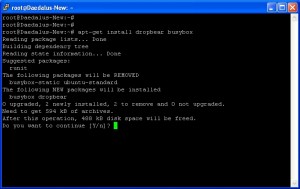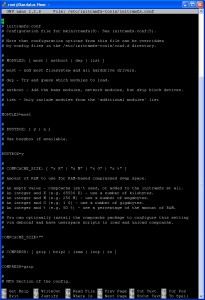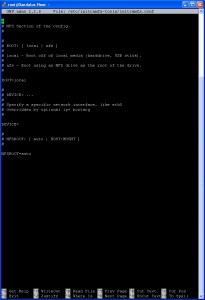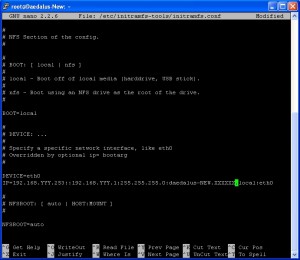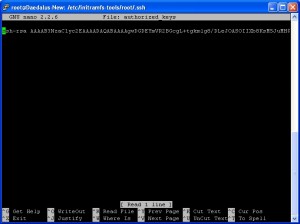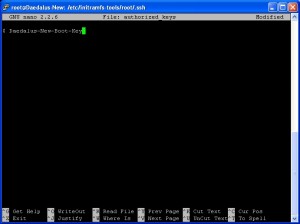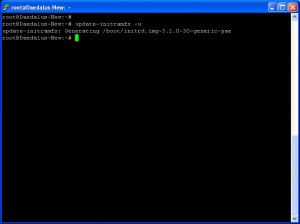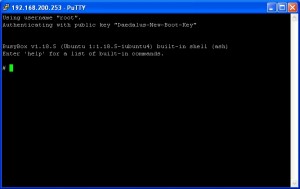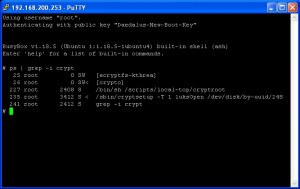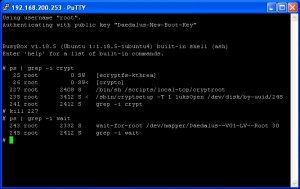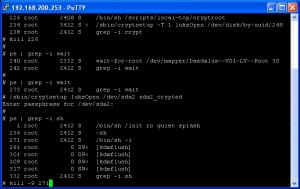In Part 1 I mentioned encrypting my disks. but didn’t go into it, so here I’m going to run through encrypting, decrypting and using it with GlusterFS.
Part 2 Was an attempted but failed install of the latest GlusterFS (3.5.0) Server
Part 3 Covered installing GlusterFS Server with the new information from Ashley
To recap I’m using the following:-
2 PI’s
2 8Gb SD Cards
2 4GB USB Sticks
2 512Mb USB Sticks.
As yet we haven’t setup any Gluster Volumes and this is all on a pretty fresh system.
First we need to install some tools we’ll be using.
apt-get install cryptsetup pv
I know my 4GB USB Stick is on /dev/sda and 512Mb is on /dev/sdb, I’ll only be concentrating on the 4Gb in this, but make sure if your following along that your using the correct paths. Using the wrong paths can wipe your data.
I dont want any partitions on the stick (I’ll be encrypting the whole drive)
fdisk -l
Shows me I’ve got a few partitions on the stick:-
Device Boot Start End Blocks Id System
/dev/sda1 ? 778135908 1919645538 570754815+ 5b Unknown
/dev/sda2 ? 168689522 2104717761 968014120 65 Novell Netware 386
/dev/sda3 ? 1869881465 3805909656 968014096 79 Unknown
/dev/sda4 ? 2885681152 2885736650 27749+ d Unknown
I can’t remember what this stick was used for (to my knowledge I’ve never used Novell partitions), but we’ll delete them all.
fdisk /dev/sda
d
1
d
2
d
3
d
wq
My partitions were listed 1-4 so it was nice and easy. You can rerun the fdisk -l command to check they’ve all gone.
This step wasn’t strictly necessary but I always like to make sure I’m working with the correct drives.
With the Drive empty of partitions I like to unplug it and plug it back in (keep everything fresh) Note: if you do reconnect the drive make sure your still working with the correct /dev/sd* path. Sometimes this can change.
Now run
cryptsetup -y -v luksFormat /dev/sda
This creates a new encryption key for the Drive (note this is not how you add new keys on a drive, only do this once!!)
Then we need to unlock the drive for use
cryptsetup luksOpen /dev/sda USB1_Crypt
/dev/sda is the drive path
USB1_Crypt is what we’re going to be labelling the decrypted drive.
You’ll be prompted for the Drive passphrase that you just created. If successful it doesn’t actually tell you, just drop you back to a prompt. From here on we wont be doing any drive work on /dev/sda as this will be outside the encrypted bit, we’ll be using /dev/mapper/USB1_Crypt
We can check it’s unlocked with
ls -l /dev/mapper/
You should see something similar to
lrwxrwxrwx 1 root root 8 May 13 18:39 USB1_Crypt -> ../dm-1
You can also check the status using
cryptsetup -v status USB1_Crypt
Now that we have the drive with an encryption key and unlocked we’ll write a bunch of data across the drive
pv -tpreb /dev/zero | dd of=/dev/mapper/USB1_Crypt bs=128M
Writing zero’s to a drive is generally considered bad for data security, but we’re writing them to the encrypted system not the actual stick, so the output to the stick will be encrypted data.
Once the data has finished writing we’ll create a new filesystem on the encrypted disk
mkfs.ext4 /dev/mapper/USB1_Crypt
You don’t have to use ext4, but I generally do.
That’s the USB Stick encrypted
We close the encrypted drive and remove it from /dev/mapper/ with
cryptsetup luksClose USB1_Crypt
If all you wanted was an encrypted Drive that’s it, and you can unlock the drive on systems with cryptsetup installed and then mount away.
So far we’ve encrypted the entire USB Stick, written a bunch of encrypted data across the entire Stick, created a new filesystem, and closed the Stick.
Now we’re ready to mount the Stick ready for Gluster to use.
We’re going to create a folder to mount the Drive into
mkdir /mnt/USB1
We’ll open the encrypted Drive again using
cryptsetup luksOpen /dev/sda USB1_Crypt
Then mount the decrypted drive
mount /dev/mapper/USB1_Crypt /mnt/USB1
If you
ls -l /mnt/USB1
You should see the lost+found directory on the filesystem.
I should mention again I’ve been running through this process on 2 PI’s, and to keep things simple I’m keeping the same names on both systems /mnt/USB1
Now it’s time to get GlusterFS running with these drives.
So while on Gluster-1(PI) issue the command
gluster peer probe Gluster-2
This should find and add the peer Gluster-2 and you can check with
gluster peer list
and
gluster peer status
Now because I always want each Gluster system working by name from Gluster-2 I issue
gluster peer probe Gluster-1
This updates the Gluster-1 peer to it’s name not it’s IP address, There’s nothing wrong with using IP addresses if your using static assigned IP’s on your PI’s, but I wouldn’t recommend doing so if your IP address is DHCP’d
With glusterfs knowing about both Gluster-1 and Gluster-2 we can create a new volume (It’s important that /mnt/USB1 has been mounted on both system before proceeding)
On either PI you can create a new replica volume with
gluster volume create testvol replica 2 Gluster-1:/mnt/USB1 Gluster-2:/mnt/USB1
This will create a new volume called testvol using /mnt/USB1 on both PI’s. The folder /mnt/USB1 is now referred to as a brick. and volumes consist of bricks.
Now we start the volume
gluster volume start testvol
Finally we need somewhere to mount the gluster filesystem
mkdir /media/testvol
Then we mount it
mount.glusterfs Gluster-1:/testvol /media/testvol
It doesn’t matter which host we use in this command, apparently it’s only used to pull the list of bricks for this volume and will then balance the load.
Now you can write data to /media/testvol. If you’ve mounted the volume on both PI’s you will see the files on both.
You can also
ls -l /mnt/USB1
To see the actual files on the stick (DO NOT do any more than just read the files from /mnt/USB1, playing in this folder can cause issues, you should only be using /media/testvol from now on).
If instead of replica you used a stripe, you’ll be able to see all the files in /media/testvol but only some files in /mnt/USB1 on each PI.
Shutting down 1 of the PI’s in a replca mode volume wont show any difference in /media/testvol (and hopefully on the new 3.5.0 version wont cause you as much of a headache if files get updated while 1 PI is offline, though it is likely to need manual intervention to fix maybe a part 4 🙂 when I get that far) but in striped mode with 1 of the PI’s offline you’ll notice files in /media/testvol have gone missing. For this reason I’m hoping to do both stripe and replica to keep files available across multiple PI’s and allow me to increase the storage space easily.
Replicating across 2 drives will mean I will need to add new storage 2 drives at a time.
Replicating across 3 drives would mean I need to add 3 new drives each time.
Just to make things easy I’ll list the commands to decrypt and mount after the PI has been reboot
cryptsetup luksOpen /dev/sda USB1_Crypt
mount /dev/mapper/USB1_Crypt /mnt/USB1
mount.glusterfs Gluster-1:/testvol /media/testvol

